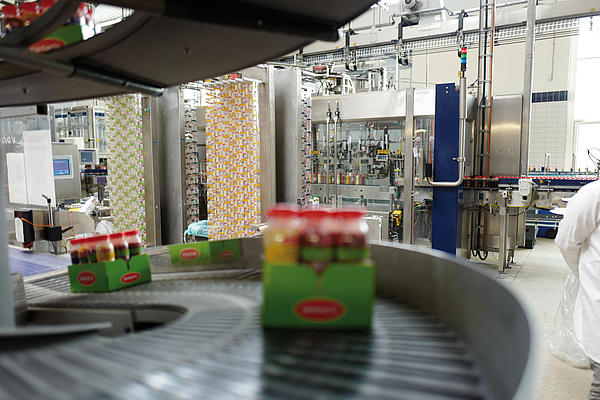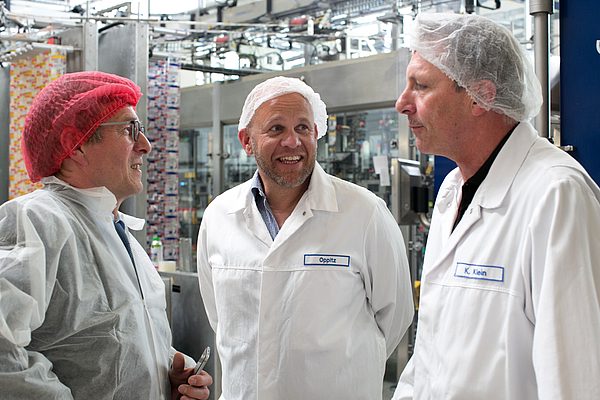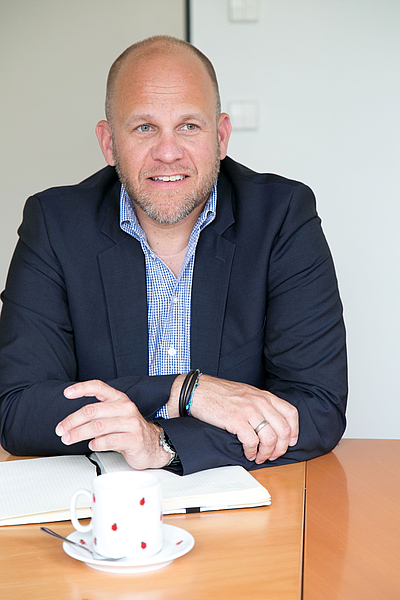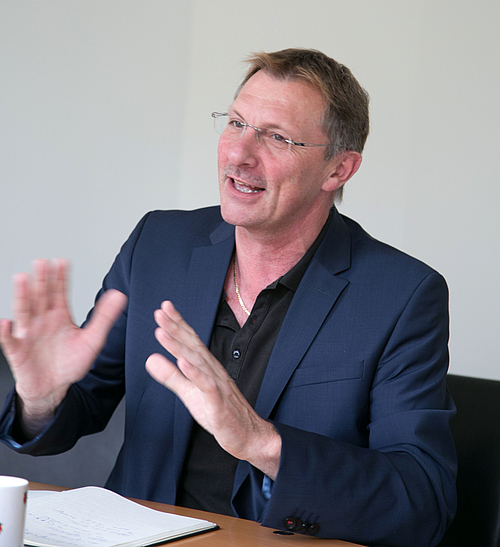

The Gropper dairy company, with its headquarters in the German town of Bissingen, is an own brand specialist producing dairy products, fresh fruit juices and smoothies for trading companies all over Europe. The family-run Gropper company founded in 1929, has since evolved into a medium-sized dairy company with more than 720 employees. At the Bissingen site alone, milk, milk mix drinks, yoghurts, fresh fruit juices and smoothies are bottled across 15 filling lines.
We had the opportunity to speak with Karl Klein, Managing Director for Production and Technology, and Christian Oppitz, Managing Director for Marketing and Distribution about the challenges of today’s market for fresh milk, fresh fruit juices and smoothies, and about this market as a niche market for PET.
How did Gropper come to use PET?
Klein: At the end of 1995, we were co-packers for companies such as Weihenstephan, Südmilch and Landliebe, and as such, we focussed on returnable glass bottles for yoghurt, milk and cream on three filling lines. When our old facility became too small, we made a fresh start here in Bissingen. In 2003, we lost a major customer and suffered dramatic sales losses. This forced us to reconsider our focus and it became quite clear quite quickly that we would go into PET. You mustn’t forget that at the time, forecasts predicted that within 4–5 years, PET would be the only material used. There was a kind of goldrush amonst machinery manufacturers as everyone added PET packages filling lines to their portfolio. At that time, most dairy companies did not have enough room on site for a large PET plant. However room was something that we had more than enough of, thanks to the considerable size of our returnable glass bottle plants, so we made a clean break by switching to PET. Focussing on the new packaging material at the same time as concentrating on drinkable yoghurt as a product catapulted us to the top of the league table. Glass continued to be on the way out, so in 2006 we switched another one of our glass lines for a PET line. We waved good-bye to the last glass line in 2008. There was a brief intermezzo involving pouches, but this is not something I would care to repeat.
Oppiz: Just to give you an idea of the numbers: At that time, our turnover with glass was around € 50 million. Today, we do not work with glass at all. In 2015, our turnover exceeded € 400 million, which was partly driven by growth in the PET sector. We have completely turned our operations around within the space of 20 years – what a feat! Today, we operate 15 lines, four of which are PET lines. We have 2 filling lines for filling EloPak gable-top containers, 8 lines for filling cups, and our most recent addition is a line for filling 1 kg buckets.
Klein: Some dairy companies have tried to introduce PET rather half-heartedly. This may work for cups, but certainly not for PET bottles. Our goal soon became to fill the way that we sell. Let me explain: We were one of the first filling companies to use the “four-colour filler”, a line which is able to fill four different products at the same time. Once filled, the four different products are sorted in the tray, loaded and delivered to the shops. This was an important step for us to take. At the same time, we were delighted to have opted for screw caps when we introduced PET, instead of the sort of sealing tops used for HDPE bottles.

Fig. 1: Filled and packaged, the products undergo fully automatic transportation to the palletiser.
That certainly is a big change. Switching from glass to PET must surely have been supported by some careful marketing?
Oppitz: That is certainly true. And there is another important and fundamental aspect which marketing had to take into consideration, namely the development from “spoonable” to “drinkable” products. Mr Klein has already mentioned that the initial euphoria was short-lived because the German and European markets did not develop quite as expected. We really thought these new products would take off like a shot in Germany. The fact is, however, that drinkable yoghurt is still not doing that well in the German market, unlike in the rest of Europe, where the market grew quickly. Luckily, we were able to benefit from this European growth as we had both the capacity and the right customers. To name just one example: Today, we deliver to Lidl in 26 European countries. In those countries, there is still considerable growth potential for drinkable yoghurt, despite the reluctance from German consumers.
How diverse is the product range in these areas?
Oppitz: It goes without saying that a wide range of products are filled on these four lines. Even when we started, we had both sweet and acidic products. Coffee and milk mix drinks, such as banana milk shake or chocolate milk, are classed as sweet products, while yoghurts are counted as acidic products. The wide range of products we fill contain between 0 and 5% fat, some are highly viscous, some highly liquid, and they all come in various bundle sizes. This kind of diversity is extremely important for sales. However, it creates great challenges for the production process – particularly when it comes to the seasonal business for various products, which peak during the summer months.
So, it is a complex business which requires flexibility in the lines. Are plant manufacturers able to provide this level of complexity and to respond by developing the right concepts? Or do you design your own plants?
Klein: Market demands are reflected in the highly complex plant design. This does mean that we do have to design our own plants. I know from experience that traditional PET plant manufacturers only have limited knowledge of milk as a raw material. And a milk line is completely different from a water-filling line, as water does not contain fat – or protein, more importantly. To get back to your question about plant design, I would say that we set the pace for planning and process technology.
Alongside the demands created by the product characteristics of milk, the freshness of the filling products must also play an important role.
Oppitz: Absolutely. Freshness and chilled distribution bring with them very specific requirements. For example, producing in advance for the season is not an option. We need a sophisticated planning system which takes into consideration the fact that our customers order 48 hours in advance. We have to ensure that we are able to deliver – which requires great experience, a high-bay warehouse, and an eye on the weather forecast.

Fig. 2: Filling line 13, which was taken into operation at the end of 2013, can be seen in the background.
So supply chain management is the key to your economic success?
Klein: Yes, certainly. Once you have made sure that the plant itself is running smoothly, it is all about the management. Any changeover takes time: Just think about this: if four products are filled at the same time, these four products must be held in stock. Once tanks are empty – and ideally, all four should run empty at the same time – the next products must be ready to go. And these need to already have been through processes such as blending or pasteurising.
Oppitz: Another factor is that these plants produce a number of different bottle sizes and a number of different products: Coffee, smoothies, drinkable yoghurt – this does indeed make things very complex. Much more so than filling water or carbonated soft drinks.
Are the various products sold in the same sales regions?
Oppitz: Well, we do see some regional differences, but generally speaking they are the same. Some products do show variations, though: While take-away coffee has been extremely popular in Germany for years, this is not the case in Italy, where consumer behaviour is entirely different. This also goes for smoothies and fresh fruit juice: these markets are much more advanced in the UK and Scandinavia than in Germany.
What does sustainability mean for Gropper?
Oppitz: Consumers’ perception of sustainability is shaped by the way we present ourselves in the market. We regularly have to undergo audits to demonstrate our sustainability to the trading companies for whom we produce. Sustainability and CSR (corporate social responsibility) set strict sustainability goals, and this is a good thing.
Klein: To me, sustainability means that a company has low fluctuation and a stable, long-standing management team. Having said that, lean management and direct access to employees is vital nowadays to being an attractive employer.
Oppitz: Sustainability is a bit of a buzzword though. We have always worked sustainably, long before it became fashionable. Our company is a third-generation family business, which is itself a sort of sustainability, and above all shows that we have been operating sustainably.
Klein: Sustainability is always driven by economic considerations, too. This is why we always stay on top of the latest technical and technological developments, and regularly reassess our processes. We always keep an eye on energy management, in other words we try to be as economical as possible in terms of energy consumption. We produce 90% of our electricity ourselves, and we also use a heat recovery system.
In relation to this, how satisfied are you with the new, innovative products, equipment and concepts which your suppliers offer nowadays? Are there certain points in the process chain for which there is no perfect solution yet?
Klein: Sales always aim for diversity and flexibility. To this end, we are continually optimizing and managing our processes in production and technical development, which is a considerable challenge for us. There is always something new to be added – additional flavours, more bundle sizes and new sales markets with their own specific demands. This actually costs us time, because changing products or containers means having to stop the plant. There is no solution to this problem in the market – at least, not yet.

Fig. 3: Christian Oppitz (right); Karl Klein (left)
But couldn’t you just solve the issue of changing labels by using direct printing techniques?
Klein: This is something that we have been looking into, of course. But the technology currently available is not compatible with our four-colour filler, which requires the labels to be printed in sequence – one bottle after the other.
Are you hoping that digitalisation will make it somewhat easier to manage the complexity of your production processes?
Klein: Please don’t forget where the trend is headed: more variety and smaller lot sizes. We work with Forecast, which means that our plants are constantly monitored as part of the continuous improvement process. This involves looking at actual production times for any particular product in great detail. The start of sterilisation, followed by the filling process itself and then cleaning – all these steps together are defined as a campaign. On a PET line, cleaning and sterilisation alone take up to 6 hours, depending on how complex the plant is. Then you have to add the change of product and label. A critical examination shows that you then no longer have 90% plant availability, but just a little over 50% – if you’re lucky. I find it difficult to say whether digitalisation could help us become more efficient here.
Oppitz: We already have a highly integrated planning process covering all areas, using SAP, which also directly incorporates our main suppliers. You could say that they know what we produce. We have to manage around 2,000 different packaging items.

What does future orientation mean for Gropper?
Klein: We will not be able to halt the trend towards increasing complexity. This means that everyone will try to differentiate themselves, and this heightened complexity comes at a cost. For us, future orientation means being ready for this.
Oppitz: Even branded companies don’t have any money to waste here, but we are driven to extremely cost-efficient production because of our own brands. Translating complexity into productivity is the answer. Markets cannot any grow larger, so new, different products will be pushed into the market. The trend towards customising will make markets smaller and the challenges greater. You may be able to buy all kinds of strawberry yoghurt, but ultimately it will always be just that: strawberry yoghurt. The new trends and the challenges that they bring have to be met head-on. They affect all areas of our work, from plant and process technology down to the variety of products and packaging available. If we don’t respond to a trend, someone else will. Take Coca-Cola, for example: The company has taken great lengths in recent years to make the brand more emotional, to bring it closer to the consumer: Cans and bottles with your own name on them – just think of the complexity required to pull this off.
Klein: (laughs) Maybe we should consider printing a personalised “good morning” on each yoghurt pot.
Oppitz: This reminds me of Mr Gropper, who said: We operate in saturated markets, having to make the saturated feel hungry.

In conclusion, could I ask you to say a few words about customer orientation?
Oppitz: We focus on our own brands, which means that we only “borrow” brands from our customers. To illustrate this: We try to put on our customer’s shoes and walk in them. Delivering quality is a matter of course. Meeting today’s quality expectations also means not damaging a brand – regardless whether it is an own brand or the brand of a branded company.
One last question: The price of milk is a constant source of controversy in Germany.
Oppitz: A lot of the discussion is political and often in response to current events, such as the Dairy Summit. Why does there have to be a Dairy Summit? In spite of the differences in the structure of the dairy industry between southern and northern Germany, the situation is equally difficult everywhere. In a nutshell: If something that no-one needs is produced in too large quantities, then prices plummet. This is what is happening at the moment, and it is partly due to situations which did not arise overnight: Russia and China were gigantic export markets, which have been lost. We have to expect some consolidation of the markets. You could say that globalisation has finally hit our farmers and our agriculture.
Klein: And subsidies haven’t solved this problem. In the past, some ill-advised incentives were given out. And another element which plays a role in Germany is the fact that consumers have become bargain-hunters.
Mr Klein, Mr Oppitz, thank you very much for talking to us.
The comPETence center provides your organisation with a dynamic, cost effective way to promote your products and services.

magazine
Find our premium articles, interviews, reports and more
in 3 issues in 2026.


